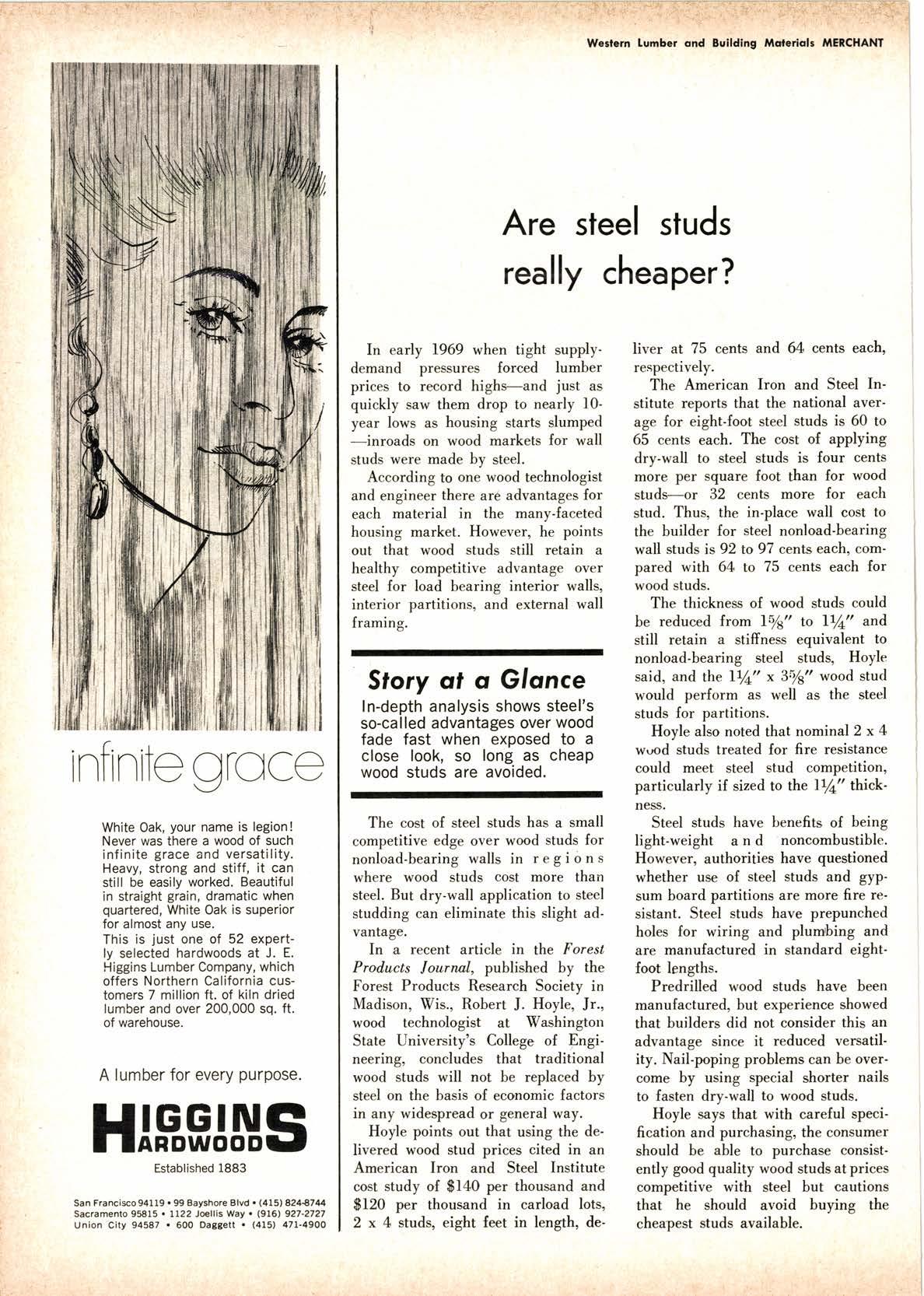
3 minute read
irrfinilegroce
White Oak, your name is legion! Never was there a wood of such infinite grace and versatility. Heavy, strong and stiff, it can still be easily worked. Beautiful in straight grain, dramatic when quartered, White Oak is superior for almost any use. This is just one of 52 expertly selected hardwoods at J. E. Higgins Lumber Company, which offers Northern California customers 7 million ft. of kiln dried lumber and over 200,000 sq. ft. of warehouse.
A lumber for every purpose. Hl,GoSlXtS
Are steel studs really cheaper?
In early 1969 when tight supplydemand pressures forced lumber prices to record high+-and just as quickly saw them drop to nearly l0year lows as housing starts slumped -inroads on wood markets for wall studs were made by steel.
According to one wood technologist and engineer there are advantages for each material in the many-faceted housing market. However, he points out that wood studs still retain a healthy competitive advantage over steel for load bearing interior walls, interior partitions, and external wall framing.
Story ot o Glonce
In-depth analysis shows steel's so-called advantages over wood fade fast when exposed to a close look, so long as cheap wood studs are avoided.
The cost of steel studs has a small competitive edge over wood studs for nonload-bearing walls in regions where wood studs cost more than steel. But dry-wall application to steel studding can eliminate this slight advantage.
In a recent article in the Forest Prod,ucts lournal, published by the Forest Products Research Society in Madison, Wis., Robert J. Hoyle, Jr., wood technologist at Washington State University's College of pngineering, concludes that traditional wood studs will not be replaced by steel on the basis of economic factors in any widespread or general way.
Hoyle points out that using the delivered wood stud prices cited in an American Iron and Steel Institute cost study of $140 per thousand and $I20 per thousand in carload lots, 2 x 4 studs, eight feet in length, de- liver at 75 cents and 64 cents each, respectively.
The American Iron and Steel In' stitute reports that the national average for eight-foot steel studs is 60 to 65 cents each. The cost of applying dry-wall to steel studs is four cents more per square foot than for wood studs--or 32 cents more for each stud. Thus, the in-place wall cost to the builder for steel nonload-bearing wall studs is 92 to 97 cents each. compared with 64 to 75 cents each for wood studs.
The thickness of wood studs could be reduced firom I\/e" 6 17/n" and still retain a stiffness equivalent to nonload-bearing steel studs, Hoyle said, and the IL/+" * 3|t/8n' wood stud would perform as well as the steel studs for partitions.
Hoyle also noted that nominal 2 x 4 w.rod studs treated for fire resistance could meet steel stud competition, particularly if sized to the l/4" thickne$9.
Steel studs have benefits of being light-weight and noncombustible. However, authorities have questioned whether use of steel studs and gypsum board partitions are more fire resistant. Steel studs have prepunched holes for wiring and plumtbing and are manufactured in standard eightfoot lengths.
Predrilled wood studs have been manufactured, but experience showed that builders did not consider this an advantage since it reduced versatility. Nail-poping problems can be overcome by using special shorter nails to fasten dry-wall to wood studs.
Hoyle says that with careful specification and purchasing, the consumer should be able to purchase consistently good quality wood studsatprices competitive with steel but cautions that he should avoid buying the cheapest studs available.
Setling Paint
(Continued, lrom Page 11) confidence. The paint sales area also should be stocked with specialty painting items like brushes, rollers and sundries. And since a cus. tomer does not initially come to a lumber yard to buy paint, a lumber dealer should locate a paint department where all customers can see it -not to the side or to the back of the sales area.
To display its line of trade paints, Pittsburgh Paints desigaed an award-winning lighted floor display as well as a more compact counter display. Both show all 720 colors available at a glanceno need to flip cards or rotate stands. The more popular colors are displayed in a wider variety of tints and shades.
In addition, PPG desigrred several other imaginative sales tools to go along with the color system. One, the Color Planner, is a pocket-size loaner booklet in which the most popular colors from the Custom Color Collection are arranged in color harmony sequence, allowing the customer to create effective color schemes in confidence. Another, the Rip-A-Chip color card, allows buyers to rip individual color chips from the card and hold each against walls, draperies and upholstery to ascertain the color's effect in isola. tion from other chips.
CONTINUED NEXT










